The following article was sourced from a Wikipedia page at the following address:
http://en.wikipedia.org/wiki/List_of_edible_seeds
LIST OF EDIBLE SEEDS
This list of edible seeds includes seeds that are directly foodstuffs, rather than yielding derived products.
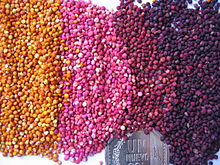
Quinoa, a pseudocereal
A variety of species can provide edible seeds. Of the six major plant parts, seeds are the dominant source of human calories and protein. The other five major plant parts are roots, stems, leaves, flowers, and fruits. Most edible seeds are angiosperms, but a few are gymnosperms. The most important global seed food source, by weight, is cereals, followed by legumes, and nuts.
The list is divided into the following categories:
-
Legumes, including beans and other protein-rich soft seeds.
-
Cereals (or grains) are grass-like crops that are harvested for their dry seeds. These seeds are often ground to make flour. Cereals provide almost half of all calories consumed in the world. Botanically, true cereals are members of the Poaceae, the true grass family.
-
Pseudocereals are cereal crops that are not grasses.
-
Nuts are botanically a specific type of fruit, but the term is also applied to many edible seeds that are not nuts in a botanical sense.
-
Gymnosperms produce nut-like seeds but neither flowers nor fruits.
LEGUMES
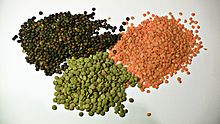
Lentils
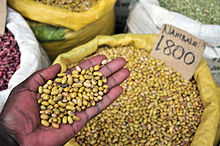
Beans at a market
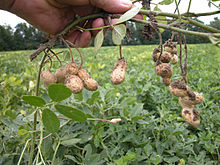
Freshly dug peanuts
Beans and other legumes, or pulses, include:
-
Bambara groundnut
-
Chickpea
-
Cowpeas
-
Dry beans, including
-
Common bean
-
Several species of Vigna, such as the lentil
-
Fava or broad bean
-
Hyacinth bean
-
Lupin
-
Moringa
-
Pea
-
Peanut, also known as groundnut
-
Pigeon pea
-
Soybean
-
Sterculia species
-
Velvet bean
-
Winged bean
-
Yam beans
Although some beans can be consumed raw, some need to be heated before consumption. In certain cultures, beans that need heating are initially prepared as a seed cake. Beans that need heating include:
-
Acacia species (wattleseed), such as mulga (Acacia aneura), Halls Creek wattle (A. cowleana), southern ironwood (A. estrophiolata), umbrella bush (A. ligulata), Murray's wattle (A. murrayana), curara (A. tetragonophylla), witchetty bush (A. kempeana), wiry wattle (A. coriacea), mallee golden wattle (A. notabilis), ranji bush (A. pyrifolia), bardi bush (A. victoriae), coastal wattle (A. sophorae), shoestring acacia (A. stenophylla), and pindan wattle (A. tumida).
-
Atriplex nummularia – old man saltbush
-
Brachychiton species, such as kurrajong (Brachychiton populneus), northern kurrajong (B. diversifolius), desert kurrajong (B. gregorii), and red-flowered kurrajong (B. paradoxus).
-
Bruguiera gymnorhiza – black mangrove
-
Calandrinia balonensis – parakeelya
-
Canarium australianum – mango bark
-
Canavalia rosea – beach bean
-
Entada phaseoloides – St. Thomas bean
-
Eucalyptus species, such as tammin mallee (Eucalyptus leptopoda) and coolibah (E. microtheca)
-
Marsilea drummondii – nardoo
-
Portulaca species, such as common purslane (Portulaca oleracea) and large pigweed (P. intraterranea)
-
Nymphaea gigantea – giant waterlily
-
Rhyncharrhena linearis – purple pentatrope
CEREALS
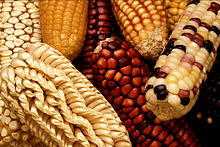
Maize
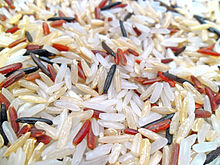
A mixture of rices, including brown, white, red indica and wild rice (Zizania species)
True cereals are the seeds of certain species of grass. Maize, wheat, and rice account for about half of the calories consumed by people every year. Grains can be ground into flour for bread, cake, noodles, and other food products. They can also be boiled or steamed, either whole or ground, and eaten as is. Many cereals are present or past staple foods, providing a large fraction of the calories in the places that they are eaten. Cereals include:
-
Barley
-
Fonio
-
Maize
-
Oats
-
Palmer's grass
-
Pearl millet
-
Rice
-
Rye
-
Sorghum
-
Spelt
-
Teff
-
Triticale
-
Wheat
-
Wild rice
Other grasses with edible seeds include:
-
Astrebla pectinata – barley Mitchell grass
-
Brachiaria piligera – wattle signalgrass
-
Eragrostis eriopoda – woollybutt grass
-
Panicum species, such as native millet (Panicum decompositum) and hairy panic (P. effusum)
-
Themeda triandra – kangaroo grass
-
Yakirra australiensis – bunch panic
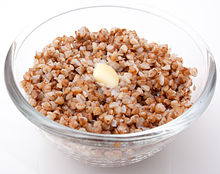
Cooked buckwheat
Pseudocereals
-
breadnut
-
Buckwheat
-
Cattail
-
Chia
-
Flax
-
Grain amaranth
-
Hanza
-
Kañiwa
-
Pitseed goosefoot
-
Quinoa
-
Sesame
NUTS
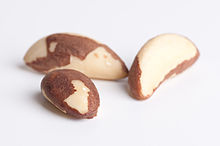
Brazil nuts
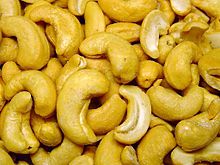
Roasted and salted cashew nuts
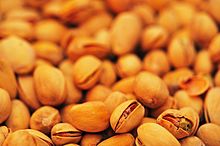
Roasted pistachios
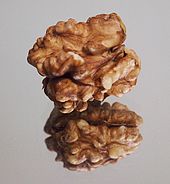
A whole walnut kernel
According to the botanical definition, nuts are a particular kind of seed. Chestnuts, hazelnuts, and acorns are examples of nuts under this definition. In culinary terms, however, the term is used more broadly to include fruits that are not botanically qualified as nuts, but that have a similar appearance and culinary role. Examples of culinary nuts include almonds, coconuts, and cashews.
-
Acorn
-
Almond
-
Beech
-
Brazil nut
-
Candlenut
-
Cashew
-
Chestnuts, including:
-
Chinese chestnut
-
Sweet chestnut
-
Chilean hazel
-
Coconut
-
Egusi and other melon seeds, including:
-
Colocynth
-
Malabar gourd
-
Pepita
-
Ugu
-
Hazelnuts, including:
-
Filbert
-
Hickory, including:
-
Pecan
-
Shagbark hickory
-
Indian beech
-
Kola nut
-
Macadamia
-
Malabar almond
-
Malabar chestnut
-
Mamoncillo
-
Mongongo
-
Ogbono
-
Paradise nut
-
Pili
-
Pistachio
-
Walnuts, including:
-
Black walnut
-
Water chestnut
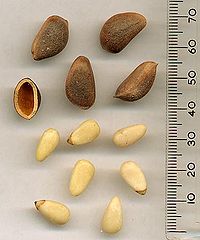
Pine nuts
Nut-like gymnosperm seeds
-
Cycads
-
Ginkgo
-
Gnetum
-
Juniper
-
Japanese chestnut
-
Monkey-puzzle
-
Pine nuts, including
-
Pinhão
-
Chilgoza pine
-
Korean pine
-
Mexican pinyon
-
Piñon pine
-
Single-leaf pinyon
-
Stone pine
-
Podocarps
OTHER
-
Cempedak
-
Cocoa bean
-
Coffee bean
-
Durian
-
Fox nut
-
Hemp
-
Jackfruit
-
Lotus seed
-
Sunflower seed
To read more about edible seeds, please click on the following link:
http://en.wikipedia.org/wiki/List_of_edible_seeds
